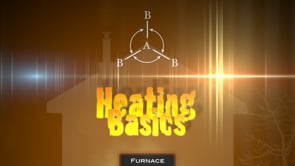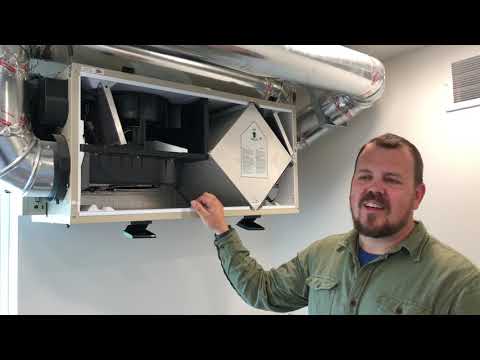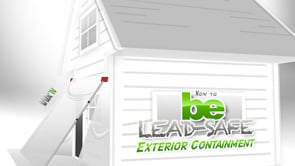How a blower door works, how to set it up, how to use it to find air leaks in a home's envelope, and how to break down the numbers.
As blower door tests creep into local building codes, it pays to know what they are and how they work. It may even be worth buying a blower door if you are serious about home performance.
These videos are from the Montana Weatherization Training Center's WxTV. There are a lot more videos over there.
How it works:
A blower door pulls air from inside the house to the outside. This depressurizes the house—it creates negative pressure inside. The amount of pressure is 50 pascals, which is roughly equivalent to a 20 mph wind.
Because nature abhors a vacuum, the air that is sucked out is replaced by air that slides in through cracks and holes in the outer shell of the house. Some common locations for holes and cracks are:
- Windows
- Doors
- Where framing meets foundation
- Penetrations for gas or oil pipes
If a large enough volume of air is pulled out of the house, it can cause replacement air to come back down the chimney. This is called backdrafting, a dangerous condition because chimney exhaust contains noxious gases, including deadly carbon monoxide.
Prep the space, set it up:
Ben sets up a blower door in an interesting house with vaulted ceilings, which will make calculating the volume of air a little more tricky. Also, the house is made from straw bales, so they are interested top see how tight it is right out of the box.
Prep Steps
- Make sure interior doors are open and exterior doors are closed.
- Look for holes in the walls—gas lines, dryer vents, etc. These will be spots to check later, during the test.
- Shut off combustion appliances, like the gas range, gas dryer, gas water heater, etc.
- Make sure wood stoves and fireplaces have not been used for a few days so that you don't suck hot coals into the living space. Close the flues while you're at it.
- Also look for asbestos, lead paint, and fibrous insulation that may be displaced with 50pa of pressure. If asbestos is present, do not do a blower door test; walk away and hire an asbestos remediator.
- Look for holes in the ceiling, like attic hatches, mechanical chases, etc.
- This house has a tongue-and-groove ceiling; ideally, there will be a continuous layer of drywall underneath it.
- Measure the volume of the home. This house has a vaulted ceiling, which makes calculating the volume more fun.
Setup Tips:
- If you are setting the door up in the only entrance to the house, make sure you bring everything into the house that you'll need.
- When setting up the door, keep all of the knobs on the same side—this makes it easier to adjust.
- Roughly fit the frame to the doorway before adding the fabric to the frame. Leave the frame a bit small because the fabric takes up space.
- Pull plenty of hose through the door before setting the door in place. 15-20 feet of hose ought to get it far enough away from the fan to give an accurate atmospheric reading.
- Pull the fabric tight over the frame using your hands and feet to tighten knobs and levers.
- Set the fan on a level surface, depending on the threshold height of the door. This can avoid excessive fan wobble (EFW).
- Keep controls to one side of the fan so that you do not block the fan while you are pushing buttons.
The blower door test process:
In this episode, WxTV inserts a special segment: an interview with a building scientist Anthony Cox, who explains that the physics of air, heat, and water change when tightening a house. He explains that there are life-safety issues with tightening that must be considered. This is not just about caulk guns and hammers.
The guys in the field must understand the details of the work that they set out to do in order to accomplish it correctly. Sometimes Anthony uses a blower door during sealing, to see if he's hitting the big spots.
Testing with a blower door
1. Get a baseline pressure test using a manometer (press the baseline button). The baseline stabilizes at about 0.8 pascals.
2. Next, set the time average—the number of readings you average to determine the actual value. If there is more fluxuation between readings, choose a higher number to average. If it is windy outside, choose the "Long" setting.
3. Decide which ring to insert into the fan—leakier houses will need bigger rings because the fan will need to move a lot of air.
4. Turn on the fan. Turn it on slowly, bring it to about 20 pascals and do a walk through of the house to make sure that ashes are not flying around or other pressure-related problems have not developed before going up to the full 50 pascals. If all is well, slowly turn it up to 50. The reading on this test was 2,100 cubic feet per minute.
Note: If you have difficulty getting it up to 50 pascals, check that a door or window is not open; also check the ring size—perhaps you need a larger ring.
5. When fan is stabilized to 50 Pa, look for air leaks. Feel with your hand around the holes you located earlier. If you can't feel a leak, you can use a smoke pencil or puffer. (An example is shown at the 5:30 mark in the video.) Document the leaks—outlets, windows, pipes, seals in wood stoves, flues, etc. The point is to find things that can be fixed easily.
6. The video also demonstrates using an infrared camera in association with a blower door to spot leaks. A look at the tongue and groove ceiling with the IR gun shows a lot of air leaking in at the beam connection.
Breaking down the numbers:
NOTE: This video begins with the exact same segment as the first video on this page. Skip to the 2:17 mark to get to the part about interpreting results and making a plan
The Numbers:
- Air moved: 2,100 cfm
- Volume of house: 15,600 cubic feet
- (2100 cfm) x (60 minutes) = 126,000 cubic feet of air per hour leaks through the house at 50 pascals of pressure.
- (126,000) / (15,600 cubic feet of house) = 8 air changes per hour at 50 pascals, or 8ACH50
At the 5:30 mark in the video, Ben opens his toolbox to talk about a couple of tools of the weatherization trade:
- Measuring devices: standard tape measure and a laser tape measure.
- Smoke puffers: Ben used an acid based puffer, but there are also silica based puffers, lightable puffers, and liquid based puffers.
Thank you Montana Weatherization Center for doing such good work and sharing it with the crowd.











